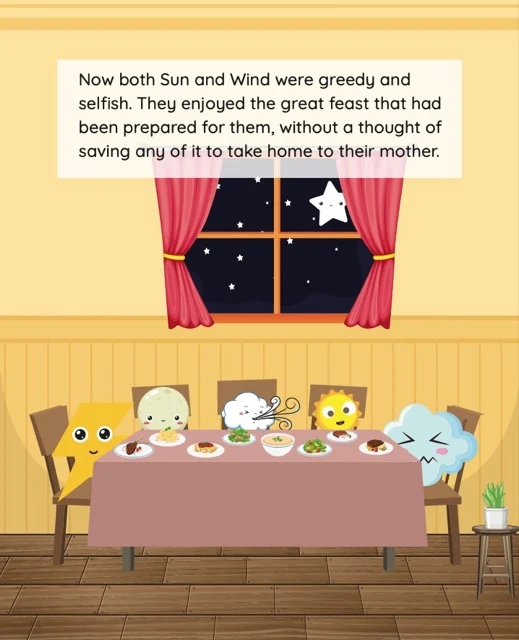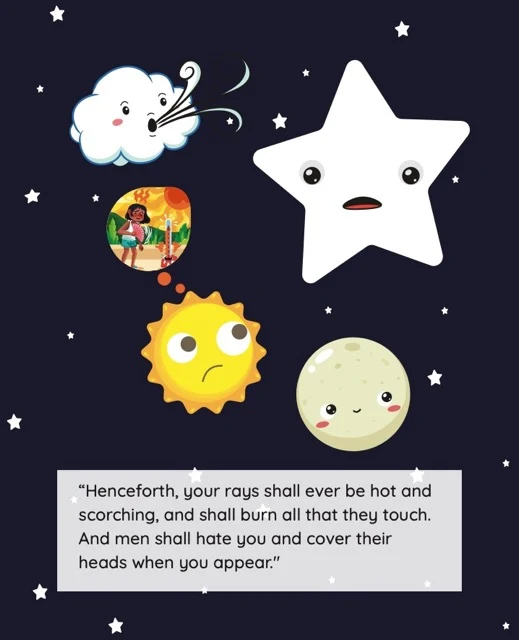The Sun, Moon, and Wind: A Fable of Gentleness
The provided text analyzes the fable "The Sun, Moon, and Wind," focusing on its central conflict between the Sun and Wind's contrasting approaches to achieving a goal. The story highlights the superiority of gentleness and patience (represented by the Sun) over aggression and force (represented by the Wind). Visual elements are noted as enhancing the narrative's impact. The fable's themes resonate with similar stories emphasizing the effectiveness of kindness and perseverance. Symbolic interpretations of the characters are explored, linking them to broader concepts of human behavior and responses to different approaches.
The Sun, Wind, and the Power of Gentleness
Briefing Doc: The Sun, Moon, and Wind
Main Themes:
●
The Power of Gentleness: The story emphasizes that kindness and gentle persuasion are often more effective than force or aggression. The Sun's success in making the man remove his coat demonstrates the power of warmth and understanding over brute force.
●
Different Approaches to Power: The contrasting methods of the Sun and the Wind highlight different ways to exert influence. The Wind's reliance on strength fails, while the Sun's subtle and persuasive approach prevails.
●
The Value of Patience and Understanding: The Sun's victory illustrates the importance of taking a measured and patient approach. Rushing to achieve a goal through force may be counterproductive.
Most Important Ideas/Facts:
●
The Central Conflict: The Sun and the Wind are engaged in a dispute over who is stronger. "The Sun and the Wind were having a silly argument about who was stronger." (Source: The Sun, Moon, and Wind: FAQ)
●
The Challenge: They decide to test their strength by seeing who can make a man walking along the road take off his coat.
●
The Wind's Approach: The Wind attempts to force the man to remove his coat by blowing with all his might. "The Wind thought that if he blew hard enough, the man would be forced to take off his coat to stay comfortable." (Source: The Sun, Moon, and Wind: FAQ)
●
The Man's Reaction to the Wind: The man resists the Wind's force by holding onto his coat even tighter. "In response to the Wind's forceful gusts, the man clung even more tightly to his coat, seeking to protect himself from the cold." (Source: The Sun, Moon, and Wind: A Study Guide)
●
The Sun's Approach: The Sun uses a gentler strategy by shining brightly and warmly on the man. "The Sun decided to use a gentler approach. He shone brightly and warmly upon the man, spreading his heat across the land." (Source: The Sun, Moon, and Wind: FAQ)
●
The Man's Reaction to the Sun: The man feels the warmth of the Sun and gradually removes his coat. "As the man walked under the warm sunbeams, he started to feel hot. He unbuttoned his coat, and eventually, it became so warm that he took his coat off completely." (Source: The Sun, Moon, and Wind: FAQ)
●
The Outcome: The Sun wins the challenge, proving that gentleness is more effective than force. "The Sun won the challenge. He proved that gentle persuasion and warmth were more effective than force and blustering." (Source: The Sun, Moon, and Wind: FAQ)
●
The Lesson Learned: Both the Sun and the Wind learn that kindness and gentleness are more powerful tools than aggression. "Through this experience, both the Sun and the Wind learned a valuable lesson: kindness and gentleness often prove to be more potent than force and aggression." (Source: The Sun, Moon, and Wind: A Study Guide)
Visual Storytelling (Source: Testing Theme: The Sun,Moon and Wind.pdf):
●
The use of visuals enhances the story by clearly depicting the characters' actions and emotions.
●
The contrast between the Wind's forceful gusts and the Sun's warm rays is effectively conveyed through the images.
●
The man's reactions to both the Wind and the Sun are visually represented, making it easier to grasp the story's message.
Possible Symbolic Interpretations:
●
The Sun: Represents warmth, kindness, and a persuasive approach.
●
The Wind: Represents force, aggression, and a forceful approach.
●
The Man: Represents humanity or individuals in general, illustrating how people are more receptive to kindness than coercion.
Relevance to Other Folktales/Stories:
●
The story shares similar themes with other folktales like "The North Wind and the Sun" and Aesop's fable "The Tortoise and the Hare," which also emphasize the effectiveness of patience and gentle persuasion over brute force.
The Sun, Moon, and Wind
The Sun, Moon, and Wind: FAQ
1. What were the Sun and Wind arguing about?
The Sun and Wind were having a silly argument about who was stronger.
2. What did they see that made them want to prove their strength?
They saw a man walking along the road wearing a coat, and they decided whoever could make him take his coat off would be the stronger one.
3. What was the Wind's strategy to make the man take off his coat?
The Wind thought that if he blew hard enough, the man would be forced to take off his coat to stay comfortable. He blew with all his might, creating a powerful gust.
4. How did the man react to the Wind's efforts?
The man felt the cold wind and held onto his coat even tighter. Instead of taking it off, he bundled up to protect himself from the chill.
5. What was the Sun's approach to the challenge?
The Sun decided to use a gentler approach. He shone brightly and warmly upon the man, spreading his heat across the land.
6. How did the man respond to the Sun's actions?
As the man walked under the warm sunbeams, he started to feel hot. He unbuttoned his coat, and eventually, it became so warm that he took his coat off completely.
7. Who won the challenge, and why?
The Sun won the challenge. He proved that gentle persuasion and warmth were more effective than force and blustering.
8. What lesson did the Sun and Wind learn from this experience?
The Sun and Wind learned that kindness and gentleness are often more powerful than force and aggression. Sometimes, a gentle approach can achieve better results than a forceful one.
The Sun, Moon, and Wind: A Study Guide
Exploring "The Sun, Moon, and Wind"
Short Answer Quiz
Instructions: Answer the following questions in 2-3 sentences each.
1.
What was the central disagreement between the Sun and the Wind?
2.
Describe the Wind's method for making the man remove his coat.
3.
How did the man react to the Wind's attempts to remove his coat?
4.
What strategy did the Sun employ to get the man to take off his coat?
5.
How did the man's response to the Sun differ from his response to the Wind?
6.
Who emerged victorious in the challenge, and what was the reason for their victory?
7.
What fundamental lesson did both the Sun and the Wind learn from this encounter?
8.
How does the story's visual format contribute to your understanding of the tale?
9.
What might the man in the story represent?
10.
What other folktales or stories share similar themes with "The Sun, Moon, and Wind"?
Short Answer Quiz Answer Key
1.
The Sun and the Wind were engaged in a dispute over which of them possessed greater strength.
2.
The Wind opted for a strategy of brute force, believing that if he blew with sufficient intensity, the man would be compelled to remove his coat. He unleashed a fierce gust of wind in an attempt to achieve this.
3.
In response to the Wind's forceful gusts, the man clung even more tightly to his coat, seeking to protect himself from the cold. Rather than removing his coat, he bundled himself up further.
4.
The Sun chose a more subtle and gentle approach. He radiated warmth and bright sunlight upon the man, gradually increasing the temperature.
5.
Unlike his reaction to the Wind, the man responded positively to the Sun's warmth. He began unbuttoning his coat and eventually found it so warm that he removed it altogether.
6.
The Sun ultimately triumphed in the challenge. His victory stemmed from the realization that a gentle and persuasive approach can be more effective than sheer force.
7.
Through this experience, both the Sun and the Wind learned a valuable lesson: kindness and gentleness often prove to be more potent than force and aggression. Sometimes, a softer touch yields better results than a forceful one.
8.
The visual storytelling format, using images to depict the narrative, enhances comprehension by providing a clear visual representation of the characters' actions and emotions. This allows readers to readily grasp the plot and the contrasting approaches of the Sun and the Wind.
9.
The man in the story could be interpreted as a representation of humanity or individuals in general. The story highlights how people often respond more positively to gentle persuasion and kindness rather than forceful coercion.
10.
"The Sun, Moon, and Wind" shares thematic similarities with other folktales like "The North Wind and the Sun" or Aesop's fable "The Tortoise and the Hare." These stories often explore the idea that slow and steady wins the race, and that kindness and perseverance can be more powerful than brute force.
Essay Questions
1.
Analyze the symbolic significance of the Sun and the Wind in the story. How do their respective actions and personalities contribute to the overall theme?
2.
Discuss the effectiveness of the visual storytelling format in conveying the narrative of "The Sun, Moon, and Wind." How do the images enhance the reader's understanding of the characters, plot, and theme?
3.
Compare and contrast the approaches of the Sun and the Wind in their attempt to make the man remove his coat. What does this reveal about their characters and the story's message about different forms of power?
4.
Explore the broader implications of the lesson learned by the Sun and the Wind. How might this message apply to interpersonal relationships, conflicts, or societal challenges?
5.
Consider the potential interpretations of the man in the story. What might he symbolize, and how does his response to the Sun and the Wind contribute to the thematic significance of the tale?
Glossary of Key Terms
●
Folktale: A traditional story or legend passed down orally through generations.
●
Theme: The underlying message or idea explored in a story.
●
Symbolism: The use of symbols to represent ideas or qualities.
●
Personification: Giving human qualities to non-human entities.
●
Gentle Persuasion: Convincing someone to do something through kindness and understanding, rather than force.
●
Brute Force: Using physical strength or power to achieve a goal, often without consideration for consequences.
●
Visual Storytelling: Using images or illustrations to tell a story.
●
Narrative: The sequence of events in a story.
●
Protagonist: The main character in a story.
●
Antagonist: The character or force opposing the protagonist.
















